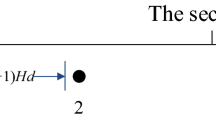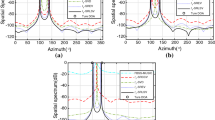Abstract
This paper investigates the two dimensional direction of arrival (2D DOA) estimation problem of multiple sources with one single moving acoustic vector sensor (AVS). We first use one single moving AVS to construct a synthetic nested AVS array, which is later shown that is equivalent to the physical nested AVS array. Then the vectorization and row extraction operations are performed to obtain the observation vector that behaves like signals received by a virtual uniform AVS array. Finally, the 2D DOA estimation is obtained via a two-step sparse representation (SR) method, which transforms the 2D grid search to a computationally efficient 1D grid search. The Cramer-Rao bound comparison between the synthetic and physical nested AVS arrays shows that these two arrays are equivalent for DOA estimation. Based on the property of the nested arrays and the full utilization of the array aperture via SR, the proposed method can achieve better estimation performance than spatial smoothing methods with nested AVS arrays and methods with uniform AVS arrays. Simulations validate the effectiveness of the proposed synthetic array method.









Similar content being viewed by others
References
Krim, H., & Viberg, M. (1996). Two decades of array signal processing research: The parametric approach. IEEE Signal Processing Magazines,13(4), 67–94.
Nehorai, A., & Paldi, E. (1994). Acoustic vector-sensor array processing. IEEE Transactions on Signal Processing,42(9), 2481–2491.
Cao, J., Liu, J., & Wang, J. (2016). Acoustic vector sensor: Reviews and future perspectives. IET Signal Processing,11(1), 1–9.
Hawkes, M., & Nehorai, A. (1998). Acoustic vector-sensor beamforming and Capon direction estimation. IEEE Transactions on Signal Processing,46(9), 2291–2304.
Zhang, X., Chen, H., & Xu, D. (2012). Trilinear decomposition-based two-dimensional DOA estimation algorithm for arbitrarily spaced acoustic vector-sensor array subjected to unknown locations. Wireless Personal Communications,67(4), 859–877.
Cheng, Z. F., Zhao, Y., & Zhu, Y. T. (2015). Sparse representation based two-dimensional direction-of-arrival estimation method with L-shaped array. IET Radar, Sonar and Navigation,10(5), 976–982.
Zhao, S., Saluev, T., & Jones, D. L. (2014). Underdetermined direction of arrival estimation using acoustic vector sensor. Signal Processing,100(7), 160–168.
Chen, H., & Zhao, J. (2005). Coherent signal-subspace processing of acoustic vector sensor array for DOA estimation of wideband sources. Signal Processing,85(4), 837–847.
Palanisamy, P., Kalyanasundaram, N., & Swetha, P. M. (2012). Two-dimensional DOA estimation of coherent signals using acoustic vector sensor array. Signal Processing,92(1), 19–28.
Zhang, X., Min, Z., & Li, J. (2013). A PARALIND decomposition-based coherent two-dimensional direction of arrival estimation algorithm for acoustic vector-sensor arrays. Sensors,213(4), 5302–5316.
Wong, K. T., & Zoltowski, M. D. (1997). Closed-form underwater acoustic direction-finding with arbitrarily spaced vector-hydrophones at unknown locations. IEEE Journal of Oceanic Engineering,22(3), 566–575.
Song, Y., & Wong, K. T. (2015). Acoustic direction finding using a spatially spread tri-axial velocity sensor. IEEE Transactions on Aerospace and Electronic Systems,51(2), 834–842.
Wong, K. T., & Zoltowski, M. D. (1997). Extended-aperture underwater acoustic multisource azimuth/elevation direction-finding using uniformly but sparsely spaced vector hydrophones. IEEE Journal of Oceanic Engineering,22(4), 659–672.
Pal, P., & Vaidyanathan, P. P. (2010). Nested arrays: A novel approach to array processing with enhanced degrees of freedom. IEEE Transactions on Signal Processing,58(8), 4167–4181.
Han, K., & Nehorai, A. (2014). Nested vector-sensor array processing via tensor modeling. IEEE Transactions on Signal Processing,62(10), 2542–2553.
Rao, S., Chepuri, S. P., & Leus, G. (2015). DOA estimation using sparse vector sensor arrays. In International Workshop on Computational Advances in Multi-Sensor Adaptive Processing (pp. 333–336).
Zhao, A., Lin, M., & Ma, X. (2017). An improved azimuth angle estimation method with a single acoustic vector sensor based on an active sonar detection system. Sensors,17(2), 412.
Zhong, X., & Premkumar, A. B. (2012). Particle filtering approaches for multiple acoustic source detection and 2D direction of arrival estimation using a single acoustic vector sensor. IEEE Transactions on Signal Processing,60(9), 4719–4733.
Autrey, S. W. (1988). Passive synthetic arrays. The Journal of the Acoustical Society of America,84(2), 592–598.
Williams, R. E. (1976). Creating an acoustic synthetic aperture in the ocean. Journal of the Acoustical Society of America,60(1), 60–73.
Edelson, G. S., & Tufts, D. W. (1992). On the ability to estimate narrow-band signal parameters using towed arrays. IEEE Journal of Oceanic Engineering,17(1), 48–61.
Stergiopoulos, S., & Sullivan, E. J. (1989). Extended towed array processing by an overlap correlator. Journal of the Acoustical Society of America,86(86), 158–171.
Stergiopoulos, S., & Urban, H. (2002). A new passive synthetic aperture technique for towed arrays. IEEE Journal of Oceanic Engineering,17(1), 16–25.
Wax, M., & Kailath, T. (1985). Detection of signals by information theoretic criteria. IEEE Transactions on Acoustics, Speech, and Signal Processing,33(2), 387–392.
Zakharov, Y. V., Baronkin, V. M., & Tozer, T. C. (2001). DFT-based frequency estimators with narrow acquisition range. IEE Proceedings-Communications,148(1), 1–7.
Li, J., Jiang, D., & Zhang, X. (2018). Sparse representation based two-dimensional direction of arrival estimation using co-prime array. Multidimensional Systems and Signal Processing,29(1), 35–47.
Yang, Z., Xie, L., & Zhang, C. (2013). Off-grid direction of arrival estimation using sparse Bayesian inference. IEEE Transactions on Signal Processing,61(1), 38–43.
Zhang, Y., Ye, Z., & Xu, X. (2014). Off-grid DOA estimation using array covariance matrix and block-sparse Bayesian learning. Signal Processing,98(5), 197–201.
Huang, T., Liu, Y., & Meng, H. (2013). Adaptive matching pursuit for off-grid compressed sensing. arXiv preprint arXiv, 1308.4273.
Stoica, P., & Arye, N. (1990). MUSIC, maximum likelihood, and Cramer–Rao bound. IEEE Transactions on Signal Processing,38(5), 720–741.
Wu, Y., Hu, Z., & Luo, H. (2014). Source number detectability by an acoustic vector sensor linear array and performance analysis. IEEE Journal of Oceanic Engineering,39(4), 769–778.
Acknowledgements
This work is supported by China NSF Grants (61371169, 61601167, 61601504), Jiangsu NSF (BK20161489), the open research fund of State Key Laboratory of Millimeter Waves, Southeast University (No. K201826), and the Fundamental Research Funds for the Central Universities (NO.NE2017103).
Author information
Authors and Affiliations
Corresponding author
Additional information
Publisher's Note
Springer Nature remains neutral with regard to jurisdictional claims in published maps and institutional affiliations.
Rights and permissions
About this article
Cite this article
Shi, Z., Zhang, X. & Zheng, W. Two-Step Sparse Representation Based 2D DOA Estimation with Single Moving Acoustic Vector Sensor. Wireless Pers Commun 111, 2561–2575 (2020). https://doi.org/10.1007/s11277-019-07003-8
Published:
Issue Date:
DOI: https://doi.org/10.1007/s11277-019-07003-8




